Just to recap – last week I did the first part of my walk around some London sights (and sites). I covered the oddly named St. Andrew By-The-Wardrobe Church, The College of Arms, St Magnus the Martyr Church with the London Bridge (1176-1831) sign, John Donne’s bust near St Paul’s Cathedral, the YMCA sign showing its origins and the very unusual Postman’s Park which became the Memorial To Heroic Self Sacrifice celebrating those who gave their lives in saving others.
For this second part it’s important to understand something of the history behind the next few pics so I hope you will bear with me. This week we’re starting with a visit to the Smithfield area and the front of St Bartholomew’s Hospital.
The first thing to notice is this sign:
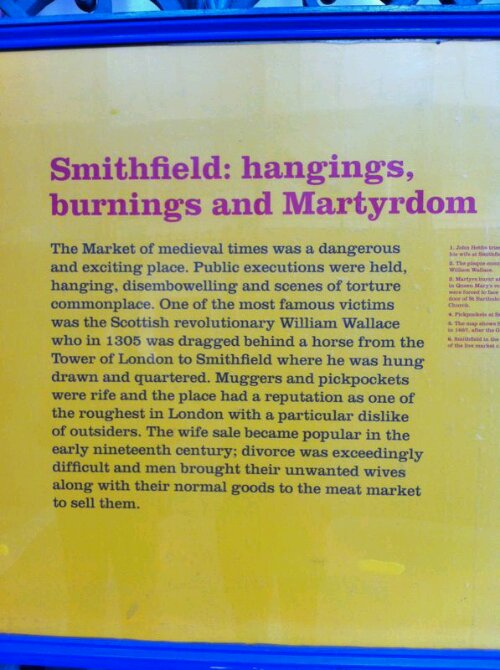
As well as the info about public executions which we’ll come to in a moment notice the bottom 5 lines of the sign. Society must have sunk to a very low level at this point!
There’s a memorial to 3 men (3 Johns) who gave their lives, not to save others like the ones in Postman’s Park, but because they refused to change their beliefs. I wonder how many of us would be prepared to die for something we believe in or would we just change our minds to stay alive. What if the government asked us to sign a piece of paper saying we definitely believe in the existence of aliens. Would it bother you? Would you sign? Maybe not? However what if they then said unless they had this piece of paper with your signature on you would not be eligible to apply for any jobs or any benefits if you are out of work. That’s a lot harder now isn’t it? Are you going to sign? What if the next step is that all who sign have to undertake not to speak to any who haven’t signed? Then ultimately what if they say if you don’t sign you no longer have the right to live? Do you sign now? Probably you do because you say it doesn’t really make much difference to your life and that’s probably right. What if though it’s not aliens but a particular belief system be it religious or secular (cult of the leader like in North Korea for instance)? There are a number of countries around the world where Christians are persecuted just because they believe Jesus died on the cross to save people from their sins. For them it’s not just a matter of changing their belief to suit the current government requirements it’s about a daily life lived a different way. This plaque is really about men for whom it was more important to stand for what they believed in rather than simply change to stay alive. Apologies for the picture being slight obscured by the railings in front of it but when I held the camera inside the railings I couldn’t get the whole thing in.
Here’s the picture:
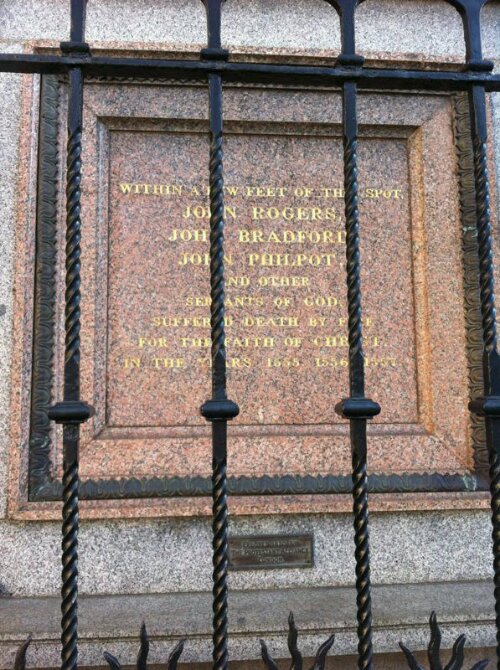
The three men are John Rogers, John Bradford, John Philpott. Let’s take a brief look at each.
John Rogers (1500-4.2.1555) was born in Birmingham and became a minister and Bible translator producing the second complete Bible translation from the original languages in 1537. He was the first Protestant Martyr (English) to be executed under Mary I. The last reported conversation JR had went something like this when Mr Woodroofe, one of the sheriffs, came to lead him out of Newgate Prison to be executed. He asked if JR was willing to revoke “his abominable doctrine”:
John Rogers: "That which I have preached I will seal with my blood."
Woodroofe: "Thou art an heretic."
John Rogers: "That shall be known at the Day of Judgment."
Woodroofe: "I will never pray for thee."
John Rogers: "But I will pray for you.”
Remember Woodroofe had come to lead the man to the stake to be burned alive; I guess I know which man’s character speaks of goodness & compassion and which one doesn’t.
John Bradford (1510-1.7.1555)
He was born in Manchester and became a law student at the Inner Temple (a professional association for barristers and judges) in London. When he became a Christian he felt called to the ministry and was later ordained by Bishop Nicholas Ridley; he would later share a cell with this man in the Tower of London. He is famous for the saying (when he saw others being led out to their execution): "There, but for the grace of God, goes John Bradford." Many of you will be familiar with the saying in its modern form when people reflect on their situation which could easily have been a lot worse if something which could have happened didn’t. They look at someone for whom it did go badly and they say: "There, but for the grace of God, go I", or just "There, but for the grace of God..” Perhaps you’ve even used the phrase yourself. Well now you know it comes from John Bradford. Before the fire was lit he turned to the man alongside him and said: "Be of good comfort brother; for we shall have a merry supper with the Lord this night!" A very strong faith indeed!
John Philpott (1511-18.12.1555)
He was born in Hampshire and the son of a knight. He studied civil law and the Hebrew language. He became archdeacon at Winchester. When Mary came to the throne he was called to account for his beliefs. Amazingly he was interviewed/examined 14 times before the final one which condemned him to death. On the appointed day the sheriffs took him to Smithfield. As they approached the stake the ground was very muddy and they offered to carry him. His reply: "Would you make me a pope? I am content to finish my journey on foot." When he got to the stake, he said, "Shall I disdain to suffer at the stake, when my Redeemer did not refuse to suffer the most vile death upon the cross for me?" He then recited the Psalm 107 & 108. When he had finished his prayers, he was tied to the post, and the fire lit.
All three died in 1555. The other years mentioned on the stone plaque must refer to the many anonymous ones who died in the following two years.
Now in the hustle and bustle of the day, with people scurrying about their daily business around me in the street, I stood for a few moments thinking about how seriously these guys took the way they lived their lives and the God they believed in to such a degree that they would simply not change to save their own lives.
Just along from this plaque was another one – this time to Sir William Wallace.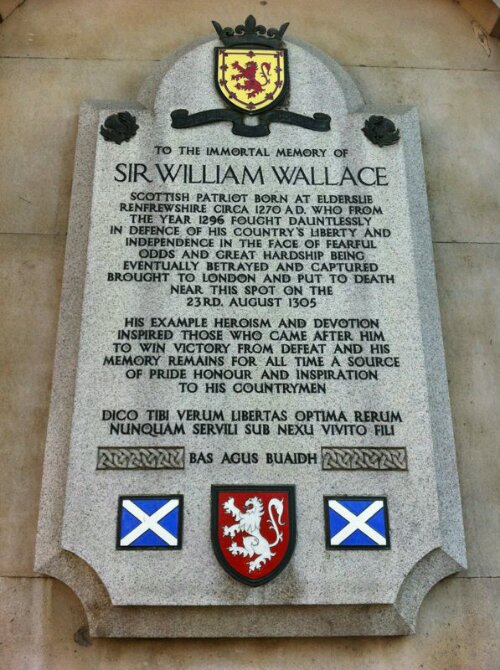
He was born nearly 300 years before the men above were burned at the stake. In 1296 Edward I of England had forced the King of Scotland, John de Balliol, to give up his throne. He then put him in jail and declared himself King of Scotland. In May 1297 Wallace and others began their resistance and a few months later the English army and the Scots met at the Forth River near Stirling. Because of the narrow bridge which the English had to cross, the outnumbered Scots actually massacred the English forces. Wallace and his men then crossed the border and, in Oct 1297, began attacking the counties of Northumberland & Cumberland. Wallace returned to Scotland in Dec 1297 and was proclaimed guardian of the realm ruling in the deposed king’s name. 8 months later in July 1298 Edward I went back to Scotland and defeated the Scots. However it was not until 1304 that the Scots actually accepted (recognised) Edward I as their king. However Wallace refused to go along with this and continued to rebel. He was captured in 1305 and taken to London where, after being condemned as a traitor, he was hanged then disembowelled, beheaded, and quartered.
The 2-line Latin inscription at the bottom Dico Tibi Verum, Libertas Optima Rerum: Nunquam Servili Sub Nexu Vivito, Fili translates to: “My Son, Freedom is best, I tell thee true, of all things to be won. Then never live within the Bond of Slavery.” He is reported to have said this at his trial (23 August 1305). Underneath it, the phrase Bas Agus Buaidh means “Death & Victory”.
So if England, or the country you live in, was invaded would you be willing to do the same? It’s a tough call isn’t it?
(Interesting to note that it was a similar story in Wales where in 1400 Owain Glyndŵr started resistance to the English king Henry IV. However even after being defeated in 1408-9 he was never captured and never betrayed. His fate is unknown but Shakespeare wrote him into Henry IV Part 1.)
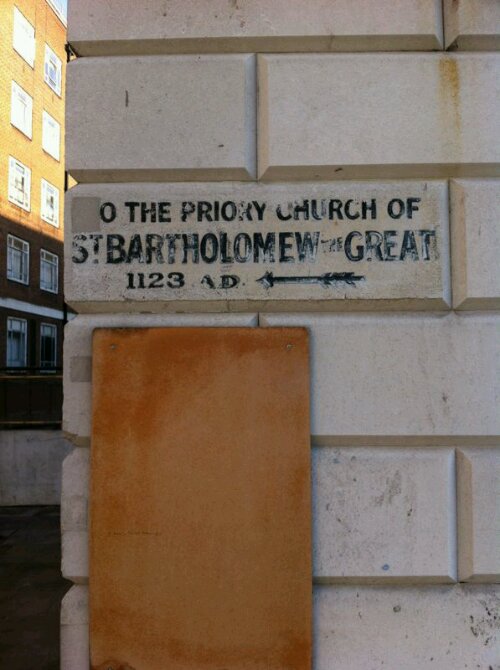
Literally, on the corner of the front wall of St Bart’s Hospital.
And just a few steps away from it is the entrance way access to the church behind:

The building was founded by a guy called Prior Rahere in 1123 as the sign said. It is claimed he built it after recovering (allegedly miraculously) from an illness. Once this became known the church used to fill up with sick people every August 24th (St Bartholomew’s Day). Sadly I cannot show you any pics inside the church itself as they were charging for the privilege and after paying an entrance fee I thought it a bit much then to ask for more money to photograph the building! However I can tell you that outside & inside there were piles of film equipment (booms, lighting, mics, cabling etc) and the guy told us they are going to be using the building to film scenes from the next Muppet movie. A man was standing guard over the piles outside to prevent theft. So just remember when you see the next Muppet film you’ll know the church interior shots were taken at St Bartholomew’s (dating back to 1123) in Smithfield, London.
Just a few minutes away and we were in the rather oddly named street – Cloth Fair. Obviously it harks back to the days when there was a cloth fair in the area and they just kept the name for the street. We stopped for a quick drink in the pub – The Hand & Shears (dating back to 1532!). In nearby Smith Field back in history tailors and drapers came from all over the country to buy & sell. Because of the risk of people not getting the correct length of cloth the Merchant Tailors would carry a yardstick and anyone found to be selling short measures of cloth were brought to this pub and taken upstairs to a courtroom where they would be tried. If found guilty it was either the stocks or a whipping! (The yardstick was known as early as the tenth century during the reign of King Edgar the Peaceful - a great-grandson of King Alfred - who reigned from 959 to 975.)
As he lived nearby it also became poet John Betjamin’s local.
Note the entrance doors are curved to fit with the rounded corner step stone and cornice above. Also check out the greenery at first floor level. I wonder who gets the job of watering that lot?
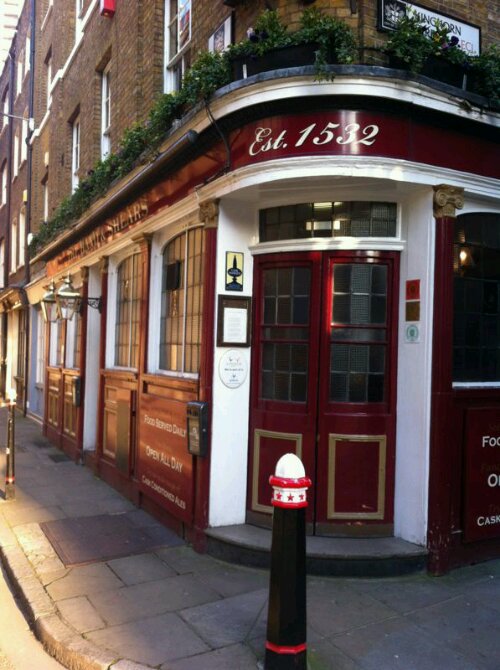
Here’s an interesting sign in the wall of a building:
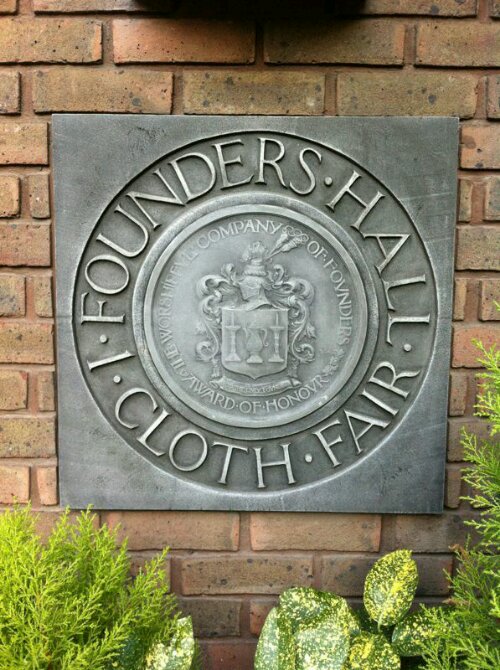
If you enlarge the pic you may be able to see the inscription round the central coat of arms. It says The Worshipful Company of Founders. Their origins go back to 1365 and it is one of earliest guilds formed to protect the interests of its members and to promote high standards of quality & workmanship in brass & bronze. You might be able to enlarge the centre bit but I was struggling to see the words. I checked their website to get the motto which is very tiny underneath the shield in the coat of arms. It is: “God The Only Founder”.
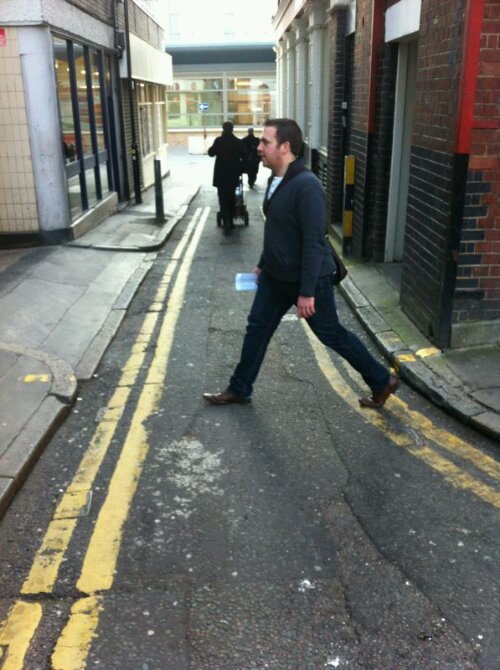
How narrow is this? It’s called Benjamin Street and is just one step and half wide. Shortly after taking this pic a small van drove through and its tyres appeared to be touching the kerbs on both sides.
Next stop was this sign outside a building which you would hardly even notice.
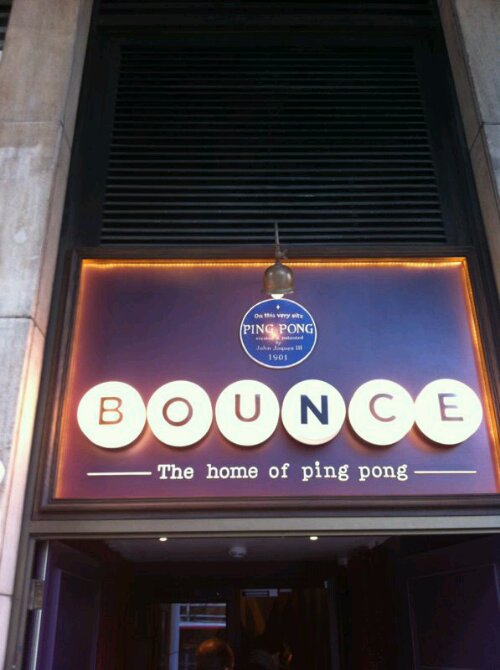
Apart from the name Bounce which you might query the blue plaque above is easy to miss as you walk along the street. The light shining on it does obscure it a bit but it says: “On this very site PING PONG was created and patented by John Jaques III 1901”. Do any of you play table tennis? By 1903 apparently the two branches (ping pong & table tennis) had joined together but there is still a large amount of verbiage on what the differences are doing the rounds today! I won’t bore you with the detail because….well… it’s boring.
Next stop was a bar for a drink; but not just any old bar – one where you have to email ahead a booking asking for permission to enter. Yes that’s right an email is required, you can’t just turn up at the door and walk in!! On arrival your details are checked and you are directed to the lifts. Up you go to floor 32. As the door opens someone is ready to take your coat if needed and another person takes you to the bar where you order your drink. Once you’ve got it you can go upstairs to floor 33 which is a viewing floor looking out over the London skyline. Here’s a pic looking down on a street below. The white tops in the long street are bus roofs: they’re white to reflect heat in the summer. Although you can’t see it in this pic the roofs also have large letters and numbers which identify the individual vehicle and the operator of that vehicle. These are used by police and emergency service airborne units
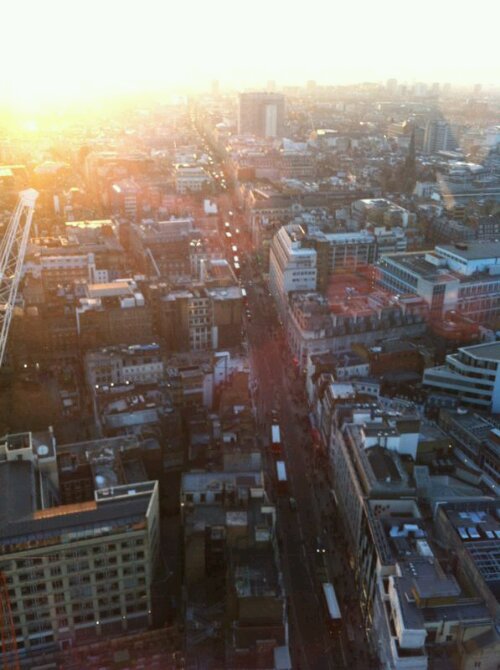
Next one is looking down on a couple of those huge building cranes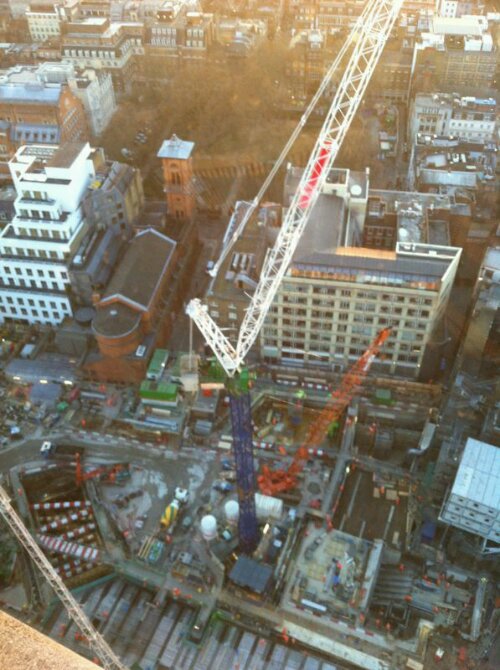
Look at the small park in the centre amongst all those buildings in the next one.
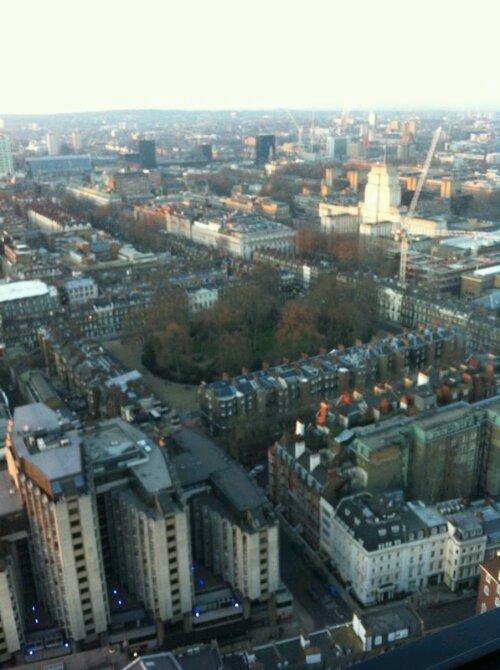
Couldn’t resist a sunset pic so here it is: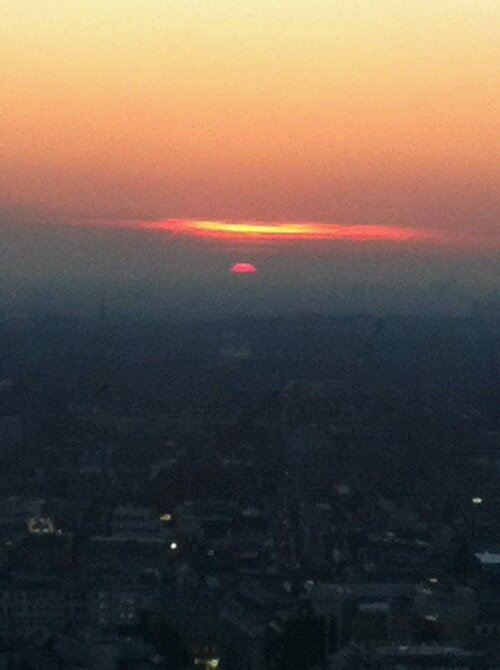
And on the way back to the station I was curious about an old odd looking building on the street corner ahead. I wondered what the Dickens it could be? As we came round the front this is what we saw: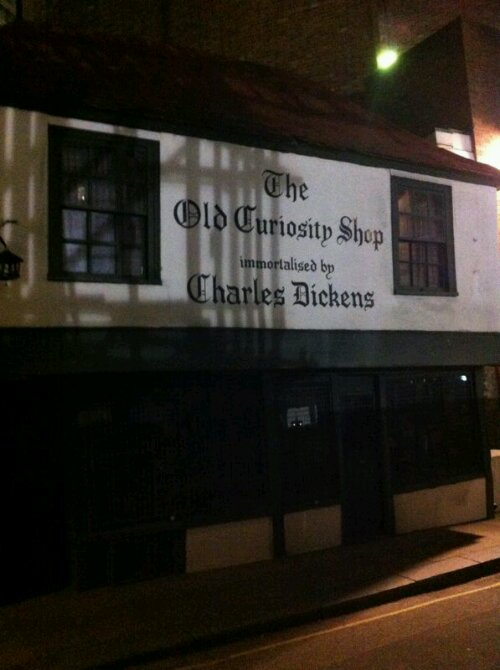
Ha ha ha. I did read that they named the shop couple of years after the book came out and not the other way round. It was built using wood from old ships. It survived the Great Fire (1666) & the WW2 bombers in the Blitz.
Although the whole walk had been less than 6 miles we’d seen so much. (My legs were convinced it had been about 12 miles!) The weather had been kind to us and we’d had a great day.
No comments:
Post a Comment